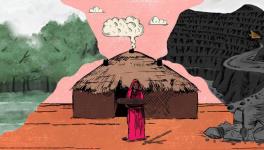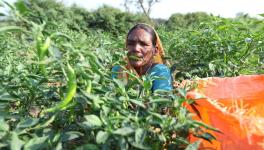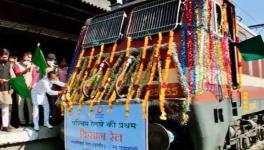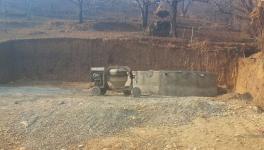Jharkhand Budget 2021–22: Cow Cemetery to Mining, A Saga of Ambiguity and Contradictions
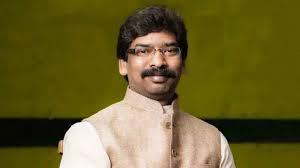
Image Courtesy: Zee News
Presenting the 20th state budget of Jharkhand on March 3 in Vidhan Sabha, the finance minister of the state, Dr Rameshwar Oraon stated, “This budget will provide everyone with food and social justice.” This might be a bizarre way to express the expected relief from the budget but these are, in reality, grave bureaucratic promises that are often made to the people of Jharkhand who still struggle against both the aforementioned problem -- hunger and social injustice.
The 2017 ‘Aadhaar PDS linking’ laid bare before us the hunger-ridden side of the state. Stories of deaths due to prolonged hunger started to come to the fore. The long history of left-wing extremism in Jharkhand, too, is an indicative of the ever-growing social injustice, inflicted mostly upon the Adivasis at the hands of big industrial and mining lords.
Since 21 years of the formation of the state, the monetary allocation for the budget has been ever increasing. This year, the total budget allocated is equivalent to Rs 91,277 crores, which is approximately Rs 5,000 crore more from the last year’s budget. The first ever-budgetary allocation for Jharkhand was quoted at Rs 7174.12, crores and since then it has experienced an overwhelming increase of almost 1200%.
The budget has been classified into three types:
1. Sector wise classification (divided as general allocation Rs 26,734.05 crores, social allocation Rs 33,625.72 crore and economic Rs 30,917.23 crore)
2. Expenditure wise classification (Rs 75,155.01 crore to revenue expenditure and 15,521.99 crore to capital expenditure)
3. Department wise classification (amount allocated to rural development is Rs 7388.42 crore, Rs 2196.36 crore to Panchayati Raj while primary education has received Rs 4039.32 crore; Rs. 2973.20 crore has been kept for agriculture and food supply has been allocated the budgetary sum of Rs 2060.13 crore, etc.)
The first prominent promise that comes for agricultural sector is the distribution of pairs of bullocks. The promise, as of now, stands at the verge of ambiguity as the budget document has not yet been published and any further assumption about the inheritance of bullock will be a mere speculation. But what can be said is that the state providing individuals with bullock may create social rifts within communities. Instead of this ‘luring’, the state government could have created measures for community tilling and irrigation. Community farming is an age-old process of the Adivasi culture and is part of their heritage that continues till date. The Jharkhand Mukti Morcha (JMM) government with Adivasi ministers in majority should have understood that they cannot provide a pair of bullocks to everyone willing to farm, and if this is something that cannot be achieved, it will only increase disparity in the rural community.
Another ambitious project of the government is the establishment of a mega-irrigation project at Dumka. The cost for the project is still unknown. The state agriculture department has been provided with an amount of Rs 2973.20 crore, which is supported by other provisions of rural economy. Also, a separate allocation has been made for farm loan waiver. The amount allocated this year is Rs 3414.97 crore. Sukhdev Singh, the chief secretary of Jharkhand has also stated that since only 5% of last year’s allocation of Rs.3362.78 crore was spent, the residue amount would also be pulled in here. Apart from that, he said “Rs 52.19 crore of remains from the previous budget allocations for the purpose would be used and additional growth can be made if required.” The state government will also establish an online portal for the farmers to apply for loan waivers.
The Jharkhand government has taken a new initiative related to the ‘Sakhi Mandals’, which are government aided self-help groups proficient in business activities. Sakhi Mandal is an organisation of Jharkhand State Livelihood Promotion Society (JSLPS) that functions under rural development. These groups provide loans to women who want to establish a business of their own, from a shop to a farm. Just last year, such Sakhi Mandals were provided with credit linkage. In the budget, the government has provided for selling the products made by the Sakhi Mandals under the brand name of ‘Palash’. However, nothing has been mentioned regarding how they will create the market for such products. Today, when the markets are intensively globalised, the handicrafts or individually crafted produce demand very high price, which eventually makes it out of the reach of the common mass. To market these in the name of culture and tradition, requires intensive work and new techniques, dynamics of which were not elaborated in the budget speech.
A very bizarre announcement of the budget is the establishment of ‘Gau Mukti Dham’, which is cow cemetery. It has been mentioned in the budget that the government plans to construct such ‘Gau Muktidham’ in every block of the state. Uttar Pradesh, the most sensitive state towards cows, still does not have such cemeteries. Madhya Pradesh, the inventor of the concept, too, does not promise this on such a large scale. Just a couple of days back, Chief Minister Hemant Soren was speaking at the “Indian Conference at Harvard”, wherein he told the moderator of the session, Dr. Suraj Yengde, that Adivasi culture is different from the Hindu religion; this is an image that he portrayed while having conversation with elite groups, but when it comes to the people of the state, promises like that only paint a different picture. If animal welfare is helmed, safer environments for living animals could have been provided for, rather the government here is focused on the spiritual part such as cremation of cows.
Jharkhand Mukti Morcha, which is the single largest party since the Vidhan Sabha elections of 2019, has included itself in the league of other ruling regional parties by commencing the establishment of cooked food schemes after the name of their supreme leader. The state government is set to open “Guruji Kitchen” across the state to provide cooked meals at economical price. In the statem, JMM patriarch Shibu Soren is often referred to as “Disom Guru” or ‘Guruji’ among his followers.
An announcement has also been made for the establishment of “Sidhu Kanhu Khel Club” in every Panchayat in Jharkhand. Considering the terrain, it can be safely assumed that there is at least one ground in every Panchayat of Jharkhand. This new promise echoes the state government‘s announcement ten months ago, by the name of “Veer Shahid poto Ho kale Vikas Yojana”, under which a construction of 5,000 stadiums across the state of Jharkhand was made. No such construction has begun yet. Since the rural dwellers are highly participative in events of sports, the lack of interest is clearly from the side of the state government. Announcement of newer schemes related to sports on every occasion, therefore, only seems more and more of a farce.
The Jharkhand government claims that this budget will strengthen the agricultural system and will uplift rural areas. For this purpose, Rs 1 8653 crores have been allocated for the rural economy, which would consist under its gamut departments like agriculture, livestock, and other related activities. Establishment of more agriculture and livestock related production centres and plants in Jharkhand have been called for by the budget, such as the following --
1. A chick reproduction centre at Kunti
2. Dairy plants at Jamshedpur and Giridih
3. Milk powder and milk products plant at Ranchi
The government has set a goal of producing 80 lakh liters of milk every day in the state. The dairy industry employs various tests to determine bacterial count, fats and freezing point, estimation of sediment, etc. Since most of these experiments are expensive and time consuming, adulteration comes easy. An ICMR report has suggested that such adulterated items have a cancerous effect on the human system and can lead to gradual impairment of the body.
Jharkhand government has also announced an incentive of Rs 1 per litre for encouraging owners to produce more. Though India’s milk output has more than doubled since 2000 and the ‘white revolution’ has increased milk productivity and processing infrastructure, all this has not transformed the farming system. ILRI says in relation to India that, “Prevalence of infectious and contagious diseases is still high and the reproductive health of dairy animals is poor. Vaccination and other disease control programmes are sporadic in nature, and antibiotic use is unregulated.” More than 50% of total marketed milk is still handled by the informal dairy sector without much knowledge and capacity- posing risk to human health. The move would maximize the producer’s share in the consumer rupee but it is equally imperative to educate farmers on better agricultural practices instead of just hovering over production.
Some of the provisions in the budget are quite ambiguous in nature such as the “Gram Vikas” schemes. Some schemes have been announced without explanation or elaboration, like the “Birsa Gram Vikas Yojana” to which a sum of Rs 61crore has been allocated. “Shaheed Gram Vikas Yojana “ is another such scheme to which a sum of Rs 5.5 crores have been allocated. The meaning behind specific usage of these funds is highly unclear as approximately Rs 18,000 crore has already been allotted for the development of rural economy. If separate allotments had been made for water supply through pipeline in villages, for construction of roads and hand pumps, etc., then what is unclear is the purpose of the above-mentioned schemes. The organisations that will handle these funds and the structure of spending it are entirely missing from the budget.
The state has registered a fall of 6.9% in its GDP since the last budget, and the economic environment is not favourable; still the government has provided for an increase of Rs 5000 crores in this year‘s budget. The optimum utilisation of the budget could have been examined if the government would have discussed their goals or projections for the money allotted to every department. For example, the agricultural sector has been provided with a sum of approximately Rs 2000 crore but they did not discuss the increase in yield they want to achieve with this allocation or how much more land they want to bring under agriculture. Also, the government has made provisions contradictory to its political stance. Though JMM prominently mentioned in its manifesto released before 2019 Vidhan Sabha elections that there will be tourism in the state instead of mining, the announcement of a new mining corridor in the district of Gridih is unpalatable. In July 2020, when the central government announced the creation of 40 coal blocks, of which 29 were in Jharkhand, the state government actively and strongly protested against this measure, subsequently moving to Supreme Court against the order.
It is clear that the JMM does not want to lose the confidence the Adivasi population has in them, but deep down they have accepted that the rural economy at present cannot substitute the mining and exploitative economy. This acceptance has birthed such contradictions. Any novel initiative related to agriculture or tourism will require the support of the people for which awareness must be generated and education must be provided. If this does not happen soon, the budgetary allocations for rural economy will start depreciating and private parties involved in excavation of mineral resources would devour the whole landscape of Jharkhand.
Arghya Bhaskar is an independent journalist based in Jharkhand. He specialises in political analysis, reporting on tribal issues, education and environment. He has written for media platforms such as Himal Southasian, The Wire, Newslaundry, Firstpost, The Quint, and Newsclick, among others.
Get the latest reports & analysis with people's perspective on Protests, movements & deep analytical videos, discussions of the current affairs in your Telegram app. Subscribe to NewsClick's Telegram channel & get Real-Time updates on stories, as they get published on our website.












